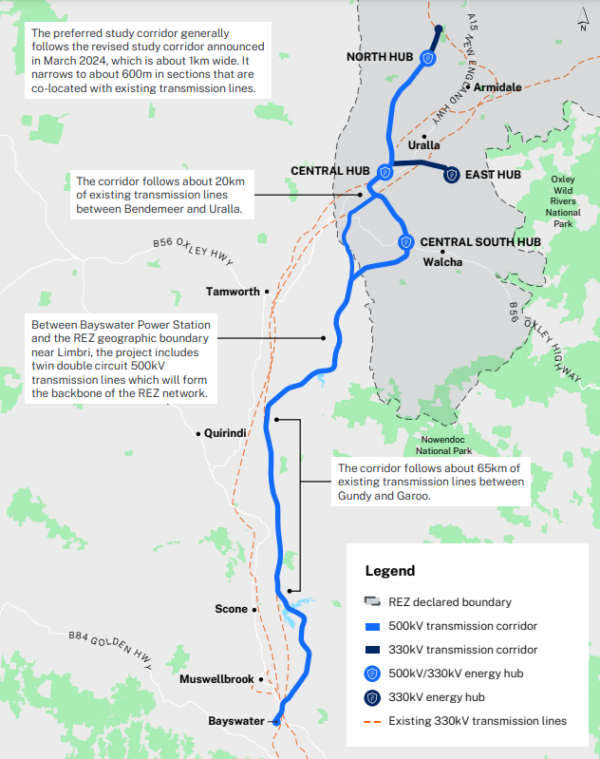This story is part of our feature series on Building the REZ in the New England.
Read more from this series here.
Consultation is king when it comes to dealing with rural communities.
The evolution of the New England region into becoming the state’s biggest renewable energy zone (REZ) is a testament to that. Farming families are facing the biggest changes to landscape around them in generations and rightly want to know all about it well before it happens.
NSW Farmers Association says many of its members thought the birth of REZ’s came with a lack of information and planning from government agencies and developers. The states’ peak farm advocacy group has since signed a Memorandum of Understanding with Energy Co on fixing the disconnect with farmers.
“Listening to the community and getting them the support they need to navigate what has been an extremely stressful and confusing process is essential,” said NSW Farmers Energy Transition Taskforce Chair Reg Kidd.
NSW Farmers also recently welcomed funding Energy and Water Ombudsman to provide independent advice and dispute resolution services to farmers and rural communities affected by renewable energy projects in NSW.
“There is a need for a fair, independent and effective avenue for rural families and farmers to address their issues with renewable developers, so we can get the right thing in the right place, built in the right way,” Mr Kidd said.
Many New England communities big and small are also on the cusp of significant change with enormous economic opportunities coupled with the challenges of increased pressure on road infrastructure and housing affordability.
Some New England REZ energy developers have recognised the need for broad and diverse consultation, which has resulted in positive outcomes for farmers and communities.
ACEN’s New England Solar project near Uralla is a good example, as is Squadron Energy’s Community Co-investment scheme that allows members of the local community to invest in the Sapphire Wind Farm.
The Winterbourne Wind project near Walcha is not a good example, according to opponents of Danish-backed development.
While much of the opposition to Winterbourne reflects a view across the New England that wind turbines are more intrusive than large scale solar projects, Voice for Walcha says a lack of transparent consultation has caused community divide.
Walcha cattle farmer Cameron Greig said a lack of open dialogue with the community spawned the formation of Voice for Walcha in 2022, of which he is a founding member.
“We grew out of the need for our community to be informed,” Cameron said.
“Engagement has been a farce. Developers have been disrespectful, they have actively avoided any meaningful interaction with the community and refused invitations to participate in community forums.”
Cameron said this has resulted in mistrust and a deficient assessment on the cumulative impact of large-scale developments.
“My main concern is the impact of a large project like this on a small community. It’s good for larger communities that can absorb the impact on things like housing availability for locals.”
“The original scale of the project that was designed by the landholders was an appropriately sized project that was supported by the community. Now it is unpalatable and has sadly caused a divide in the community.”
A group of farmers in the Winterbourne locality started the wind project 20 years ago. It was sold to the Danish-owned wind turbine company Vestas in 2019 and on-sold to investment firm Copenhagen Infrastructure Group, who are proposing 119 wind turbines.
The Fletcher family were involved in that group and their family farm will host up to nine turbines if the project gets the green light.
Holly Fletcher said the developer’s community consultation process has been open and fair.
“There is only so many times you can explain the same thing. They have a shopfront in town for direct community engagement, there are updates in the quarterly community newsletter, and they attend local events like the Walcha show.”
Holly said she feels like part of the ‘silent majority’ identified in a recent Farmers for Climate Action survey that support renewable energy projects in regional Australia.
“It has been divisive for Walcha, and is some cases it has become personal and persecutory as opposed to seeking facts.”
Holly said the positive outcomes for farmers and Walcha will be long lasting and extend beyond the life of the Winterbourne Wind project.
“The community benefit fund will generate up to $34 million over the life of the project, which I think is incredible for our town.”
Holly said more than 50 landholders, some of whom are neighbours to host properties, will be direct financial beneficiaries.
“For us, it will secure intergenerational farming succession for our family. The last drought in 2019 was a call to action on the need to diversify and adapt to those climate events.”
“Our family has been here since 1863 and now we have a real opportunity to continue that. I truly believe that wind energy generation and farming can run in parallel, as long as it done right and done with consultation.”
Holly said she is also proud to be part of the climate change solution.
“Farmers are the most impacted by climate inaction, but we are also the ones that can contribute the most improving climate outcomes.”
Getting the dialogue right for Transmission lines
Energy Co’s improved collaborative consultation approach is being tested for one of the biggest steps in the region’s renewable evolution- planning and construction of transmission lines.
Energy Co’s New England REZ deputy project director, Julian Watson said they are now progressing the development and environmental assessments for the transmission infrastructure.
“Our current focus is on undertaking the background studies for concept design, environmental assessments and consultation for transmission lines, which is very large piece of infrastructure,” Mr Watson said.
“There will be around 400 kilometres of transmission that will bring all the energy from the generators down through to the Upper Hunter to Bayswater.”
Mr Watson said there will be four energy hubs in the REZ that will act as substations to connect renewable energy projects to the transmission network.

“Those will be done in three stages. Stage one will bring on 2.4 gigawatts of capacity and then increase to six gigawatts in stage two.”
Energy Co plans to deliver stage 2 by 2033 with the final 2GW unlocked by 2043. Each Energy Hub will typically occupy up to 100 hectares will be located near planned wind and solar projects.
Not all generation projects within the REZ are connecting to the new REZ infrastructure, with some projects connecting to the existing Transgrid network. Generation projects connecting to the existing Transgrid network infrastructure will negotiate connection easements through mutually agreed arrangements with landowners and will be required to receive an offer to connect from Transgrid.
Julian said Energy Co has learned to work closer with individual farmers and landowners on planning transmission line routes.
“We have been and continue to with landowners to get an understanding of how they use their land, what is important to them and feasible options to relocate based on that.”
“It can be a challenging time for landowners when it comes to hosting new transmission lines. We recognise that and there are still plenty of discussions to be had, but I think we have a really good approach to consulting with farmers.”
“We are also doing a lot of work to understand the opportunities for communities. That includes how we best support local councils and communities to maximise the economic benefits. A lot of the generators are taking their own community support approach as well,” he said.
“If managed well, this is a real opportunity for the future of the New England region.”
This story is supported by grant funding from the Local Independent News Association (LINA) and the Meta Australian News Fund administered by the Walkley Foundation.
Like what you’re reading? Support The New England Times by making a small contribution today and help us keep delivering local news paywall-free. Support now


